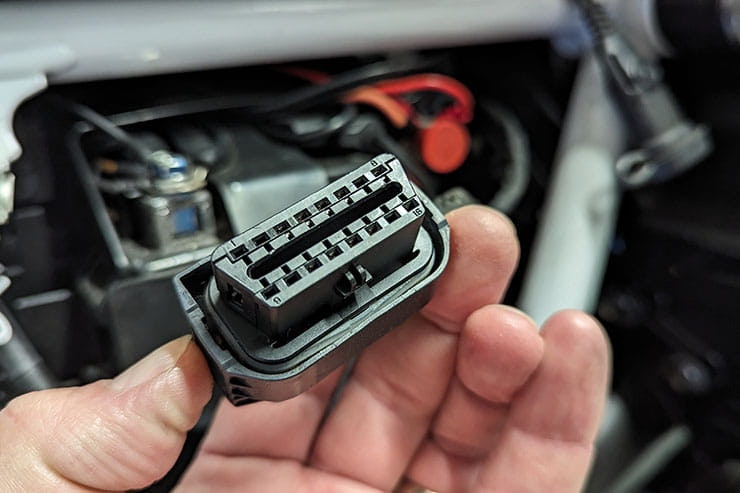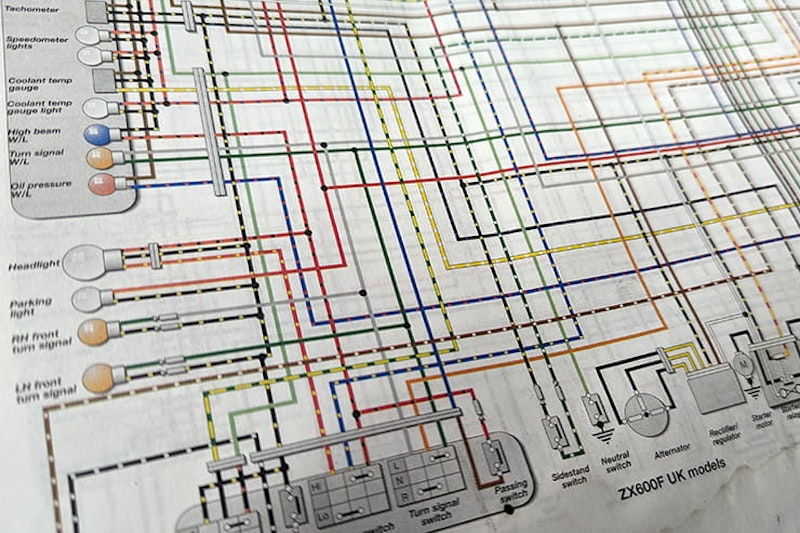The OBD (on-board diagnostics) port on your motorcycle is just the start of a labyrinth of CAN-bus data signals…
CAN-bus is basically a messaging system that allows all the electronic devices on a motorcycle to communicate with each other. The ‘CAN’ bit stands for Controller Area Network, the ‘bus’ refers to the physical wires the system uses. But why is it on so many bikes now? BikeSocial asked the experts at Optimate to help explain it…
Why do motorcycles use CAN bus?
Traditionally, a motorcycle’s electronic system starts at the battery. Any component relying on power would be wired to it, via a fuse box, to keep both battery and component safe in the event of an issue.
As machines have become more complex and increasingly reliant on electronically-controlled devices, wiring each of these directly and separately to the battery would be way too complex and bulky. CAN-bus acts as a central communication hub between the bike’s own ECU (Electronic Control Unit) and all the other devices. This sends everything down a single wiring loom; significantly reducing the amount of wiring needed, so reducing cost and complexity. Though try telling the average home mechanic that it’s less complex as they attempt to locate a brake light feed. For instance, unplugging the connector to the tail light unit might not allow you to find the supply to the brake light as easily as you might think: when CAN-bus can't 'see' the bulb or LED unit, it will sometimes switch to powering up both indicators instead, for safety.
In the old days, motorcycle wiring was a simple matter of following the colours from the battery to the bulb…
Which motorcycle manufacturers use CAN-bus?
All the major Japanese and European manufacturers now use CAN-bus in their bikes, and Harley-Davidson recently introduced it too. Ducati was the first to use CAN-bus on a motorcycle – for its 999 superbike back in 2002 – although only between the ECU, immobiliser and dashboard. BMW was the first motorcycle manufacturer to run a full CAN bus network, starting with the GS range in 2004.
How does CAN-bus benefit riders?
CAN-bus allows a wide range of safety, economy and convenience features to be implemented using software alone – functionality that would add cost and complexity if these were hard-wired using traditional automotive electrics. Essentially, we get more features, for less money.
Also, in theory, CAN-bus makes fault finding easier. Any abnormality can be displayed as a ‘fault code’ on the bike’s dashboard – just like modern cars – saving the user/mechanic time chasing electrical faults through a complex web of wiring looms and fuse boxes.
Modern CAN-bus systems make for more simple wiring diagrams, but they need to be treated with caution for the home mechanic without diagnostic equipment
What are the disadvantages of CAN-bus?
The central computer in a CAN-bus system is usually programmed to accept a certain power draw or resistance from each sub-system. When that power draw changes it will shut down the offending system. What this means is that should the rider attempt to fit any kind of electrical accessory to their machine – such as brighter headlight bulbs or heated grips – the system could shut down the circuit in question because it thinks there’s a fault. Only wiring direct from the battery will likely prevent any issues.
Caution should be used if tapping into the wire of a CAN-bus equipped bike. For instance, it might seem logical to take a feed from the main-beam circuit of a KTM 1050 Adventure to 'tell' a spotlight kit to go into full power, but the wire that feeds this halogen bulb also carries the crank position sensor data, which causes some aftermarket lamps to strobe (ask BikeSocial's Consumer Editor, John, how he knows).
Some devices will rely on a signal from the tail light, for instance, to tell them to wake up. While these can be compatible with CAN-bus if they're only 'listening' for a change in state, do check with the manufacturer before buying.
Accessories for CAN-bus equipped bikes either need to be specifically made for the particular model, or require separate third-party CAN-bus Controllers, which plug into the diagnostic port and send the proper signals to the primary CAN computer.
Using an auxiliary power output if one’s built into the bike will usually allow a switched power supply for accessories, or using devices like the Hex ezCAN (or Denali Cansmart) to add accessories without ever having to interfere with the wiring.
Despite its complexities, you needn’t worry about charging your bike’s battery if it has CAN-bus
How do you charge the starter battery on a CAN-bus equipped bike?
A flat battery can cause problems with CAN-bus systems that could need a professional reset afterwards, so battery maintenance will save a lot of time, expense and headaches.
Motorcycle manufacturers will typically say that your bike’s starter battery should be charged while disconnected, but the good news is that it’s typically safe to charge the battery of a CAN-bus equipped bike with crocodile clips or a fly-lead with a good quality, well-designed charger.
CAN-bus can also make charging the battery easier. For instance, if you have a modern BMW, the OptiMate 4 CAN-bus edition has been designed specifically for CAN-bus equipped bikes so the bike’s ECU recognises (and is happy with) the device. This means it can be plugged into the 12V DIN socket using a supplied special lead, and features Automatic keyless activation, for safe and unsupervised charging without needing to turn on the ignition to activate the charging process. There are some other chargers that can do this, but do always check that they will operate without having to manually keep the charging port open.
On some Triumphs equipped with a live DIN-socket, you can also plug in any OptiMate charger using the specially designed O-09 adapter. Find out more about OptiMate chargers at optimate1.com
If you’d like to chat about this article or anything else biking related, join us and thousands of other riders at the Bennetts BikeSocial Facebook page.

